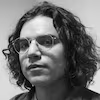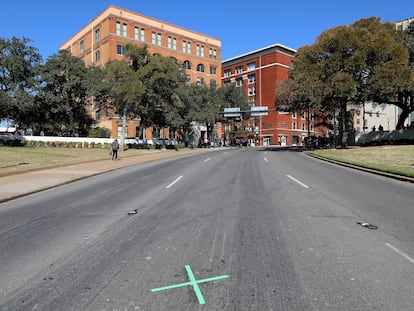A timeline of the assassination of President John F. Kennedy
60 years ago, Lee Harvey Oswald shot the President in an event that left a profound impact in American society
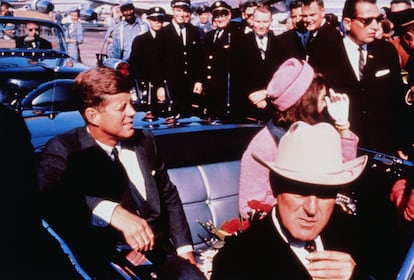
President John F. Kennedy was assassinated on November 22, 1963, in Dallas, Texas, exactly 60 years ago. His visit’s purpose was to smooth over frictions in the state’s Democratic Party between two senators, and it was also supposed to serve as an informal launch of his 1964 reelection campaign. However, history took a different turn when Lee Harvey Oswald, a former U.S. Marine, shot the President from a building while he was moving along in the presidential limousine.
The Kennedy assassination fueled conspiracy theories that persist to this day, adding an air of mystery and intrigue to the tragedy. The Warren Commission, tasked with investigating the assassination, concluded that Lee Harvey Oswald acted alone in shooting Kennedy from the sixth floor of the Texas School Book Depository. However, skepticism and alternative theories have persisted, contributing to a lingering sense of uncertainty and suspicion surrounding the event. Here’s a breakdown of the events of that fateful day.
Before the shooting
At 7:23 a.m., Lee Harvey Oswald arrives at the Texas School Book Depository in Dallas, accompanied by Buell Wesley Frazier.
Frazier questions Oswald about a long, paper-wrapped package, and Oswald dismisses it as “just some curtains”.
At 8:45 a.m., President Kennedy addresses the Fort Worth Chamber of Commerce.
Adviser Kenny O’Donnell instructs Secret Service agent Roy Kellerman not to use the presidential limousine’s bubbletop if the weather is clear in Dallas.
Kennedy views a negative advertisement in The Dallas Morning News, expressing concern about the city. Kennedy tells his wife Jackie: “We’re heading into nut country today”.
The motorcade departs Hotel Texas at 10:40 a.m. for Carswell Air Force Base.
Air Force One departs Carswell Air Force Base at 11:20 a.m. for Dallas.
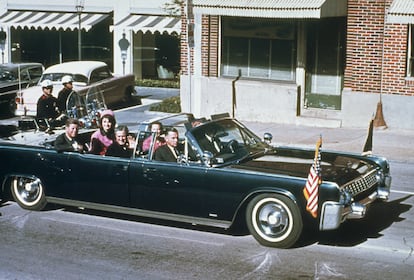
Air Force Two and Air Force One arrive at Love Field in Dallas at 11:35 a.m.
The Kennedys and Texas governor John Connally and his wife disembark Air Force One and are greeted by vice president Lyndon Johnson and his wife.
Dealey Plaza events
The motorcade departs Love Field at 11:55 a.m., delayed by the President’s interaction with supporters.
At 12:29 p.m., the motorcade turns into Houston Street and enters Dealey Plaza.
At 12:30 p.m., the motorcade makes a sharp left turn onto Elm Street, a downward-sloping road.
Witnesses recall hearing three shots as the limousine travels down Elm Street, after the president started waving with his right hand.
The Zapruder film captures the moment of impact on Kennedy and Connally. A bullet struck the President in the throat, and another in his mid-back. He is seen with an anguished expression. Secret Service Agent Clint Hill said he heard one shot, then jumped off the running board of the Secrete Service follow up-car directly behind Kennedy. He then ran towards the Presidential limo.
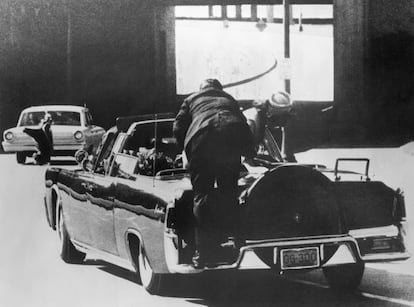
The Warren Commission report notes that seconds after the shooting, Agent Roy Kellerman looks at his watch and says “12:30″ to William Greer. He then radios Police Chief Jesse Curry and tells him the President had been shot.
As the limousine accelerates, Mrs. Kennedy climbs onto the rear, and Hill shields her and the President. The Connallys stated they heard Ms. Kennedy say, “I have brains in my hand!”. The limo driver and police motorcycles turn on their sirens and race to Parkland Hospital, approximately four miles away.
At 12:33 p.m., Oswald leaves the Texas School Book Depository. He was confronted by patrolman Marion Baker and Depository superintendent Roy Truly, who identified him as an employee. He later claimed that he “went outside to watch” (the presidential motorcade).
Police radios report shots fired at the President’s motorcade at 12:34 p.m.
At 12:36 p.m., President Kennedy’s limousine arrives at Parkland Memorial Hospital, where he is admitted with Connally to begin treatment immediately.
Aftermath
Kennedy is admitted to Parkland Hospital and receives emergency treatment. Malcolm Perry, assistant professor of surgery at the University of Texas Southwestern Medical Center and a vascular surgeon, is the first to treat the President. He performs a tracheotomy followed by cardiopulmonary resuscitation. Other medical experts try to save the president’s life but the wounds are fatal.
CBS News reports the shooting at 12:40 p.m. with anchorman Walter Cronkite. Reporter Dan Rather calls Parkland Memorial Hospital at 12:45 p.m. A doctor tells him he believes Kennedy is dead.
President Kennedy is officially pronounced dead at 1:00 p.m. Tom Shires, Parkland’s chief of surgery later said: “I am absolutely sure he never knew what hit him”. Connally is taken to emergency surgery.
Acting White House Press Secretary Malcolm Kilduff announces Kennedy’s death at 1:33 p.m. Before this, he asked new President Johnson if he could make the announcement. Johnson ordered the announcement be made after he left the hospital, as he feared the shooting was a “worldwide conspiracy” and that he was a possible next target.
Oswald leaves the depository, walks seven blocks, boards a bus, and eventually arrives at his rooming house around 1:00 p.m.
At 1:04 p.m., Oswald departs the rooming house, seen standing at a bus stop by housekeeper Earlene Roberts.
At 1:15 p.m., Oswald shoots and kills Dallas police officer J. D. Tippit. At 12:54, Tippit had received a broadcast that described a suspect in the shooting at Dealey Plaza. At approximately 1:11-1:45 p.m. he pulled alongside a man who resembled the police description. Oswald walked over to Tippit’s car and exchanged words with him through an open window. Tippit got out of the car and as he walked toward the front, Oswald drew his handgun and fired five shots. Three bullets hit Tippit in the chest. He was pronounced dead at 1:25 p.m. at the Methodist Hospital.
At 1:38 p.m. Anchorman Cronkite reports that Kennedy is dead and Johnson will be sworn in as the new President of the United States.
Johnson phones Attorney General Robert F. Kennedy, brother of the president, at 1:40 p.m., to express his condolences.
Oswald is seen at the Texas Theatre around 1:35 p.m., leading to police surrounding the theater at 1:45 p.m.
Oswald resists arrest, attempting to shoot a patrolman, and is taken into custody at 1:51 p.m. During the arrest, he yells, “Well, it’s all over now!”.
Kennedy’s body is removed from Parkland Hospital and taken to Air Force One at 2:00 p.m.
Oswald undergoes interrogation and denies involvement in the assassination.
President Lyndon B. Johnson is sworn in at 2:38 p.m., and Air Force One departs for Washington, D.C., at 2:47 p.m.
Oswald is charged with the murder of Officer Tippit at 7:05 p.m. and later charged with President Kennedy’s murder at 11:26 p.m.
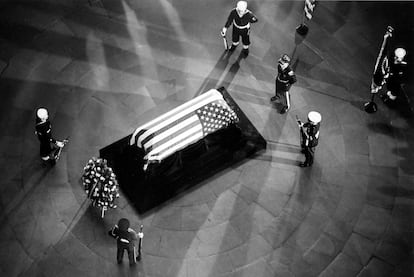
On November 24, two days after the shooting, detectives were escorting Oswald through the basement of Dallas Police Headquarters toward an armor car that was going to take him to a nearby county jail. At 11:21 a.m CST, Jack Ruby, a nightclub operator in Dallas approached Oswald and shot him once in the abdomen at close range. Oswald was taken by ambulance to Parkland Memorial Hospital — the same hospital where Kennedy was pronounced dead. Oswald tied from his woulds at 1:07 p.m.
Sign up for our weekly newsletter to get more English-language news coverage from EL PAÍS USA Edition
Tu suscripción se está usando en otro dispositivo
¿Quieres añadir otro usuario a tu suscripción?
Si continúas leyendo en este dispositivo, no se podrá leer en el otro.
FlechaTu suscripción se está usando en otro dispositivo y solo puedes acceder a EL PAÍS desde un dispositivo a la vez.
Si quieres compartir tu cuenta, cambia tu suscripción a la modalidad Premium, así podrás añadir otro usuario. Cada uno accederá con su propia cuenta de email, lo que os permitirá personalizar vuestra experiencia en EL PAÍS.
¿Tienes una suscripción de empresa? Accede aquí para contratar más cuentas.
En el caso de no saber quién está usando tu cuenta, te recomendamos cambiar tu contraseña aquí.
Si decides continuar compartiendo tu cuenta, este mensaje se mostrará en tu dispositivo y en el de la otra persona que está usando tu cuenta de forma indefinida, afectando a tu experiencia de lectura. Puedes consultar aquí los términos y condiciones de la suscripción digital.
More information
Archived In
Últimas noticias
Most viewed
- Oona Chaplin: ‘I told James Cameron that I was living in a treehouse and starting a permaculture project with a friend’
- Sinaloa Cartel war is taking its toll on Los Chapitos
- Reinhard Genzel, Nobel laureate in physics: ‘One-minute videos will never give you the truth’
- Why the price of coffee has skyrocketed: from Brazilian plantations to specialty coffee houses
- Silver prices are going crazy: This is what’s fueling the rally
